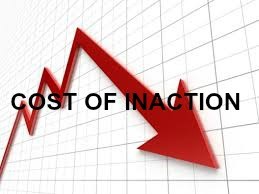The Cost of Inaction (COI) represents the tangible and intangible losses that organizations or individuals face by choosing not to act, delaying decisions or maintaining the status quo when change or investment is necessary.
Unlike the commonly measured Return on Investment (ROI), which focuses on the benefits of an action, COI highlights the consequences of inaction – often a silent yet significant drain on performance, growth and competitiveness.
The Cost of Inaction encompasses a wide range of consequences, including:
– Financial Losses: missed revenue opportunities, increased operational costs, and long-term expenses due to inefficiencies or outdated processes.
– Opportunity Costs: the benefits or profits forfeited by not pursuing new initiatives, entering new markets, or adopting innovations.
– Competitive Disadvantage: falling behind competitors who are quicker to adapt to market changes or technological advancements.
– Talent Attrition: higher employee turnover and recruitment costs when organizations fail to invest in leadership development or improved working conditions.
– Decreased Morale and Engagement: inaction can lead to demotivated staff, resulting in lower productivity, disengagement, and increased absenteeism.
– Reputational Damage: delays or indecision can erode customer trust and satisfaction, ultimately harming brand reputation.
– Operational Inefficiencies: persistent bottlenecks, errors and poor resource planning often result from a failure to update or improve processes.
– Social and Community Impacts: in broader contexts, inaction can lead to negative health, education, and social outcomes for communities or societies.
Why Is the Cost of Inaction often overlooked?
– Hidden or hard-to-measure costs: any costs of inaction, such as lost opportunities or declining morale, are not immediately visible on financial statements.
– Risk Aversion and Uncertainty: leaders may hesitate to act due to fear of failure, lack of information, or competing priorities, often underestimating the risks of doing nothing.
– Focus on Immediate Costs: organizations frequently prioritize short-term savings over long-term gains, ignoring the accumulating costs of inaction.
Some examples:
– missed market opportunities: companies that delay adopting new technology may lose market share to more innovative competitors.
– talent drain: failure to invest in employee development can lead to higher turnover, with the cost of replacing an employee estimated at 60–80% of their annual salary.
– operational bottlenecks: outdated manual processes can cause inefficiencies, errors, and slow decision-making.
– reputation loss: slow or inadequate responses to customer complaints can damage brand loyalty and result in lost business.
How to address the Cost of Inaction?
– Conduct a COI Analysis: regularly assess the risks and costs associated with inaction in key areas of your business.
– Model Opportunity Costs: include both explicit & implicit costs in decision-making frameworks.
– Prioritize Proactive Leadership: invest in leadership development and change management to foster a culture of timely, decisive action.
– Communicate the Risks: make the hidden costs of inaction visible to stakeholders to build urgency for change.
At the end, the Cost of Inaction is a critical yet often underestimated factor in business and organizational decision-making and it includes not only financial losses but also missed opportunities, decreased competitiveness, and negative impacts on people and culture.
Recognizing and quantifying COI is essential for driving timely, effective decisions and sustaining long-term growth and resilience.
By understanding and addressing the Cost of Inaction, organizations can better navigate the complexities of today’s business environment and position themselves for future success.


